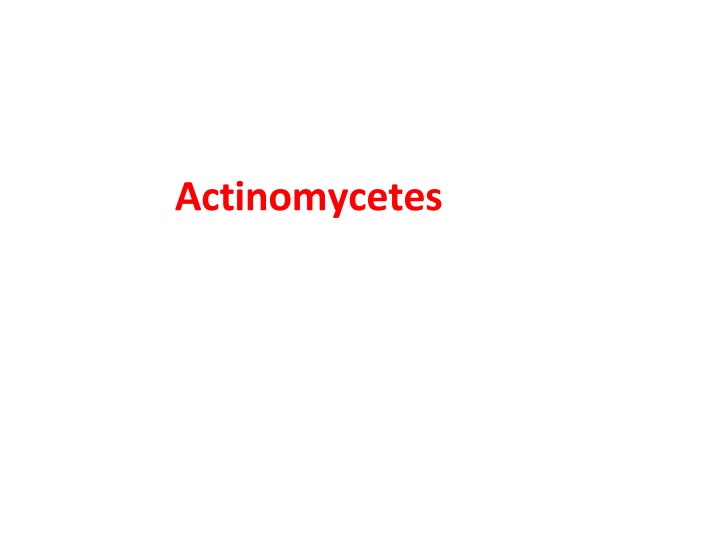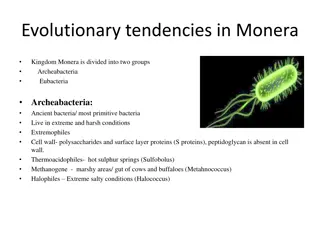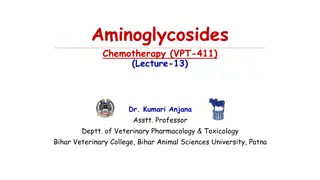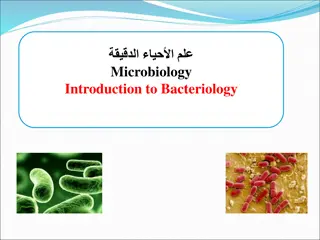Actinomycetes
Actinomycetes are a diverse group of soil bacteria with unique morphological features, including branching filaments and mycelium. They play a crucial role in degrading various compounds, inhabit oral cavities, and exhibit a range of behaviors from harmless commensals to antibiotic-resistant pathogens. Learn about their habitat, morphology, and classification in this detailed overview.
Download Presentation

Please find below an Image/Link to download the presentation.
The content on the website is provided AS IS for your information and personal use only. It may not be sold, licensed, or shared on other websites without obtaining consent from the author.If you encounter any issues during the download, it is possible that the publisher has removed the file from their server.
You are allowed to download the files provided on this website for personal or commercial use, subject to the condition that they are used lawfully. All files are the property of their respective owners.
The content on the website is provided AS IS for your information and personal use only. It may not be sold, licensed, or shared on other websites without obtaining consent from the author.
E N D
Presentation Transcript
classification Domain:Bacteria Phylum:Actinobacteria Class:Actinobacteria Order:Actinomycetales Family:Actinomycetaceae
Introduction The actinomycetes are very diverse and contain a variety of subdivisions, as well as yet-unclassified isolates, mainly because some genera are very difficult to classify because of a highly niche-dependentphenotype. For example, Nocardia contains several phenotypes first believed to be distinct species before their differences were shown to be entirely dependent on their growth conditions. Actinomycetales are generally anaerobic and have mycelium in a filamentous and branching growth pattern. Some actinobacteria can form rod- or coccoid-shaped forms, while others can form spores on aerial hyphae. gram-positive and
Introduction.. Actinomycetales bacteriophages, which are calledactinophages. Actinomycetales can range from harmless bacteria to pathogens with resistance toantibiotics. Important genera: Actinomyces Nocardia Actinomadura Streptomyces thermophilic bacteria can be infected by
Habitat Predominantly soil bacteria Good at degrading recalcitrant compounds such as chitin & cellulose. Often active at higher pH (contrast to fungi who may dominate at lower pH) Give soil the earthy smell Almost all species are commensals of the oral covity and tonsils. Some of the form the normal flora of mouth and female genital tract.
Morphology Diversegroup Grampositive Non-motile Non-sporing Non-capsulated Straight, curved or pleomorphic Arranged in chains or branching filaments Related to Mycobacteria and Corynebacteria Mycelium -- tangled mass of hyphae, found in nature
Unicellular like bacteria but produce mycelium which is non septate and more slender Like bacteria they don t like distinct cell wall Don t contain chitin and cellulose They produce hyphae and conidia / sporangia like fungi. Certain actinomycetes whose hyphae undergo segmentation resemble bacteria, both morphologically and physiologically. Note: Morphology resembles to fungi, cellular organization typical of bacteria
Difference between fungi and Actinomycetes Actinomycetes are non-motile filamentous Fungi are a group of microorganism which the includes of multicellular organisms mushrooms, moulds,etc. gram positive bacteria belonging to genus of the Actinobacteria bacteria. single cell and such as yeast, complex class Actinomycetes organisms. are prokaryotic Fungi are eukaryotic organisms. Actinomycetes contain peptidoglycan in their cell walls. Actinomycetes filaments are smaller. Fungi contain chitin in their cell wall Fungi filaments are bigger GC content in actinomycetes DNA is less than fungi. Fungi have more GC bases in DNA.
Slimarlities between Actinomycetes and fungi 1. Actinomycetes and fungi arefilamentous. 2. Both produce spores. 3. Both types are good decomposers. 4. Both groups include antibiotic producing species.
Similarities Between Actinomycetes and Bacteria Actinomycetes and bacteria are prokaryotes. They do not have a membrane-bound nucleus and organelles. Both have a cell wall made up of murine. They are microorganisms that form colonies on the solid media. Both form endospores. They occur in the environment and as a part of the normal microbiota. Both can be pathogens.
Culture characteristic Anaerobic or microaerophilic bacteria and grows well in presence of 5-10% co2. Optimum temperature 35-37 degree Celsius Grow on brain heart infusion agar/broth and thioglycollate agar containing o.12%-0.2% rabbit blood. Incudation time: 3-4 days mostely but for few speciesit extended from 1 to 2 week Colony can be rough, pigmented with chalky appearance.
Pathogenic Actinomycetes normally reside in human mouth, throat, gastrointestinal tract, and urogenital tract without producing disease. Since the organisms cannot invade a human or animal body, they must be introduced by a deep puncture wound or trauma such as dental extraction or jaw trauma, aspiration of dental debris, surgery (removal of the appendix), or prolonged use of intrauterine devices. Actinomycetes require dead or devitalized tissue to facilitate their invasion and proliferation into deeper tissues. Establishment of human infection by Actinomycetes always requires the presence of companion bacteria. These companion bacteria help in initiation of infection by producing a toxin or an enzyme or by inhibiting host immunity.
Once the infection by Actinomycetes is established, the immune system of the infected human host stimulates an intense inflammation. Bacteria from the infected site may disseminate to distant organs of the body. The Actinomycetes are particularly common type of bacteria foundon moldy hay. Farmers may be routinely exposed to very high concentrations of Actinomyces and may inhale as many as 750,000 spores per minute. Frequent exposure to Actinomyces is the causeof Farmers Lung respiratory problems.
Cervicofacial infection, which accounts for more than half of reported cases; the jaw is often involved. The disease is endogenous in origin; dental caries is a predisposing factor, and infection may follow tooth extractions or other dental procedures.
Who Get Infected Men are affected more frequently than women, and in some regions the disease is more common in rural than in town dwellers, probably owing to lower standards of dental care in the former. agricultural workers
Thoracic actinomycosis Thoracic actinomycosis commences in the lung, probably as a result of aspiration of actinomyces from the mouth. Sinuses often appear on the chest wall, and the ribs and spine may be eroded. Primary endobronchial actinomycosis is an uncommon complication of an inhaled foreign body.
Abdominal Actinomyctes Abdominal cases commence in the appendix or, less frequently, in colonic diverticulae. Pelvic actinomycosis occurs occasionally in women fitted with plastic intra-uterine contraceptivedevices.
Clinical significance Are part of the NF found in the cavities of humans and other animals. All may cause actinomycosis or lumpy jaw which is a cervicofacial infection that used to occur following tooth extractions or dental surgery which provided traumatized tissue for growth of the microorganism which may also invade the bone. This is rare today because of prophylacticantibiotictherapy. May cause thoracic or abdominal infections May cause meningitis, endocarditis, or genital infections
Every kind of infection is characterized by draining sinuses, usually containing characteristic granules which are colonies of bacteria that look like dense rosettes of club- shaped filaments in radial arrangement
Diagnosis Specimens should be obtained directly from lesions by open biopsy, needle aspiration or, sputum, sinus discharge, bronchial secretion by fibreoptic bronchoscopy. Examination of sputum is of no value as it frequently contains oral actinomycetes. Material from suspected cases is shaken with sterile water in a tube. Sulphur granules settle to the bottom and may be removed with a Pasteur pipette.
Granules crushed between two glass slides are stained by the Gram and Ziehl-Neelsen (modified by using 1% sulphuric acid for decolorization) methods, which reveal the Gram positive mycelia and the zone of radiating acid-fast clubs. Sulphur granules and mycelia in tissue sections are identifiable by use of fluoresce inconjugated specific antisera. In-situ PCR has been used to detect A. israelii in tissue biopsies.
Culture For culture, suitable media, such as blood agar or brain-heart infusion agar, glucose broth and enriched thioglycollate broth, are inoculated with washed and crushed granules. Cultures are incubated aerobically and anaerobically for up to 14 days. After several days on agar medium, A. israelii may form so called spider colonies that resemble molar teeth.
culturing Cultures are incubated aerobically and anaerobically for up to 14 days. After several days on agar medium, A. israelii may form socalled spider colonies that resemble molar teeth. The identity may be confirmed by biochemical tests, by staining with specific fluorescent antisera or by gas chromatography of metabolic products of carbohydrate fermentation.
Procedure: Various steps for the Isolation and characterization of actinomycetes were performed which are mentioned below: samples collection Enrichment of samplesusing thioglycollatebroth Sample were culture on BA, BHIA, glucosebroth Isolate was characterized by Morphological, Physiological, Biochemical and Molecular method
Strains of actinomycetes isolated Biochemicalmethods: Catalase production Urease production Hydrogen sulfide production Nitrate reduction Starch hydrolysis Gelatin liquefaction Methyl red test Vogues-proskauer test Indole production Citrateutilization Caseinhydrolysis Morphological methods: (a)Macroscopic methods Cover slip culture (b)Microscopic methods Slideculture method Molecular methods: RFLP usingany one of genomic DNA RAPD PFGE ARDRA Use of genus specificprimers Physiological methods: Rangeof pH for growth Optimum temperature forgrowth Salinity





